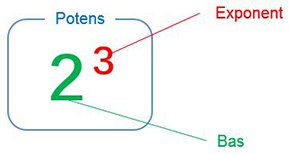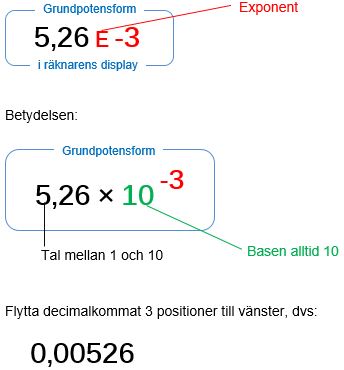Skillnad mellan versioner av "1.7 Lathund till Potenser Webbversion"
Taifun (Diskussion | bidrag) m |
Taifun (Diskussion | bidrag) m |
||
| (64 mellanliggande versioner av samma användare visas inte) | |||
| Rad 1: | Rad 1: | ||
| + | __NOTOC__ | ||
{| border="0" cellspacing="0" cellpadding="0" height="30" width="100%" | {| border="0" cellspacing="0" cellpadding="0" height="30" width="100%" | ||
| style="border-bottom:1px solid #797979" width="5px" | | | style="border-bottom:1px solid #797979" width="5px" | | ||
| Rad 5: | Rad 6: | ||
{{Not selected tab|[[1.7 Quiz till Potenser|Quiz]]}} | {{Not selected tab|[[1.7 Quiz till Potenser|Quiz]]}} | ||
{{Not selected tab|[[1.7 Övningar till Potenser|Övningar]]}} | {{Not selected tab|[[1.7 Övningar till Potenser|Övningar]]}} | ||
| − | {{Selected tab|[[1.7 | + | {{Selected tab|[[1.7 Lathund till Potenser Webbversion|Lathund Webb]]}} |
| + | | style="border-bottom:1px solid #797979" width="100%"| | ||
| + | |} | ||
| + | {| border="0" cellspacing="0" cellpadding="0" height="30" width="100%" | ||
| + | | style="border-bottom:1px solid #797979" width="5px" | | ||
| + | {{Not selected tab| }} | ||
| + | {{Not selected tab| }} | ||
| + | {{Not selected tab| }} | ||
| + | {{Not selected tab| }} | ||
| + | {{Not selected tab|[[1.7 Lathund till Potenser Appversion|Lathund App]]}} | ||
| style="border-bottom:1px solid #797979" width="100%"| | | style="border-bottom:1px solid #797979" width="100%"| | ||
|} | |} | ||
| − | |||
| − | |||
| + | == <b><span style="color:#931136">Potens</span></b> == | ||
| + | <br /> | ||
<table> | <table> | ||
<tr> | <tr> | ||
| − | <td><div class=" | + | <td>[[Image: Potens Bas Exponent_80.jpg]]</td> |
| − | < | + | <td> <div class="ovnE"> |
| + | <big>Potens med positiv exponent<span style="color:black">:</span> | ||
| − | + | <math> \quad\;\;\; 2\,^{\color{Red} 3} \; = \;\; \underbrace{2 \, \cdot \, 2 \, \cdot \, 2}_{{\color{Red} 3}\;\times} \; = \; 8</math> | |
| − | <b> | + | <b><span style="color:#931136">Potens</span></b> = upprepad <b><span style="color:red">multiplikation</span></b> |
| − | + | av <math> \, 2 \, </math> med sig själv, <math> \, {\color{Red} 3} \, </math> gånger. | |
| − | </div> | + | </big></div> |
</td> | </td> | ||
| − | |||
</tr> | </tr> | ||
</table> | </table> | ||
| + | <br /> | ||
| + | <table> | ||
| + | <tr> | ||
| + | <td><div class="ovnA"> | ||
| + | <big>Potens med exponenten <math> \, {\color{Red} 0} \, </math><span style="color:black">:</span> | ||
| + | <math> \qquad\quad \displaystyle 2\,^{\color{Red} 0} \;\; = \;\; 1 </math> | ||
| + | </big></div> | ||
| − | |||
| − | |||
| − | |||
| − | |||
| − | |||
| − | |||
| − | |||
| − | |||
| − | |||
| − | |||
| − | |||
| − | |||
| − | |||
| − | |||
| − | |||
| − | |||
| − | |||
| − | |||
| − | |||
| − | |||
| − | |||
| − | |||
| − | |||
| − | |||
| − | |||
| − | |||
| − | |||
| − | |||
| − | |||
| − | |||
| + | </td> | ||
| + | <td> <div class="ovnC"> | ||
| + | <big>Potens med negativ exponent<span style="color:black">:</span> | ||
| − | < | + | <math> \qquad \displaystyle 2\,^{\color{Red} {-3}} \; = \;\; \frac{1}{2\,^{\color{Red} {3}}} \; = \; \frac{1}{8} \quad </math> |
| − | + | ||
| − | + | <b><span style="color:red">Invertera</span></b> potensen med positiv <math> \quad </math> | |
| − | + | exponent. | |
| − | + | ---- | |
| − | : | + | Att <b><span style="color:red">"invertera"</span></b> t.ex. <math> \, 10 \, </math> ger <math> \, \displaystyle {1 \over 10} \; </math>. |
| + | </big></div> | ||
| + | </td> | ||
| + | </tr> | ||
| + | </table> | ||
| − | |||
| − | ::::<big><math> \displaystyle{a^x \over a^x} \; = \; 1 </math></big> | + | == <b><span style="color:#931136">Potenslagarna</span></b> == |
| + | <br /> | ||
| + | <div class="border-divblue"> | ||
| + | <b><span style="color:#931136">Första potenslagen:</span></b> <big><math> \qquad\qquad\quad\;\, a^x \cdot a^y \; = \; a\,^{x \, + \, y} \qquad\qquad </math></big> | ||
| + | ---- | ||
| + | <b><span style="color:#931136">Andra potenslagen:</span></b> <big><math> \qquad\qquad\qquad\;\;\; \displaystyle {a^x \over a^y} \; = \; a\,^{x \, - \, y} \qquad\qquad </math></big> | ||
| + | ---- | ||
| + | <b><span style="color:#931136">Tredje potenslagen:</span></b> <big><math> \qquad\qquad\qquad \displaystyle {(a^x)^y} \; = \; a\,^{x \, \cdot \, y} \qquad\qquad </math></big> | ||
| + | ---- | ||
| + | <b><span style="color:#931136">Lagen om nollte potens:</span></b> <big><math> \qquad\qquad\quad\;\;\, a\,^0 \; = \; 1 \qquad\qquad </math></big> | ||
| + | ---- | ||
| + | <b><span style="color:#931136">Lagen om negativ exponent:</span></b> <big><math> \qquad\quad\;\;\; a\,^{-x} \; = \; \displaystyle {1 \over a\,^x} \qquad\qquad </math></big> | ||
| + | ---- | ||
| + | <b><span style="color:#931136">Potens av en produkt:</span></b> <big><math> \qquad\qquad\;\, (a \cdot b)\,^x \; = \; a\,^x \cdot b\,^x \qquad\qquad </math></big> | ||
| + | ---- | ||
| + | <b><span style="color:#931136">Potens av en kvot:</span></b> <big><math> \qquad\qquad\qquad\, \left(\displaystyle {a \over b}\right)^x \; = \; \displaystyle {a\,^x \over b\,^x} \qquad\qquad </math></big> | ||
| + | </div> <!-- border-divblue --> | ||
| − | |||
| − | + | == <b><span style="color:#931136">Grundpotensform</span></b> == | |
| − | </ | + | <br /> |
| + | ::[[Image: Grundpotensform_60b.jpg]] | ||
| − | <div class=" | + | <div class="border-divblue"> |
| − | == <b><span style="color:#931136"> | + | == <small><b><span style="color:#931136">Definition:</span></b></small> == |
| − | + | ||
| − | |||
| − | |||
| − | |||
| − | |||
| − | |||
| − | |||
| − | |||
| − | |||
| − | |||
| − | |||
| − | |||
| − | |||
| − | |||
| − | |||
| − | |||
| − | |||
| − | |||
| − | |||
| − | |||
| − | |||
| − | |||
| − | |||
| − | |||
| − | |||
| − | |||
| − | |||
| − | |||
| − | |||
| − | |||
| − | |||
| − | |||
| − | |||
<big> | <big> | ||
| + | <b><span style="color:#931136"><math> a \cdot 10\,^n \; </math></span></b> kallas <b><span style="color:#931136">grundpotensform</span></b> om <b><span style="color:#931136"><math> n \, </math></span></b> är heltal och <math> \; 1 \leq </math> <b><span style="color:#931136"><math> a </math></span></b> <math> < 10 \; </math>. | ||
| − | + | Dvs <b><span style="color:#931136"><math> \, a \, </math></span></b> måste vara mellan <math> \, 1,\ldots \, </math> och <math> \, 9,\ldots \; </math>.</big> | |
| − | + | </div> | |
| − | + | ||
| − | + | ||
| − | + | ||
| − | + | ||
| − | + | ||
| − | + | ||
| − | + | ||
| − | + | ||
| − | + | ||
| − | + | ||
| − | + | ||
| − | + | ||
| − | + | ||
| − | + | ||
| − | + | ||
| − | + | ||
| − | + | ||
| − | + | ||
| − | + | ||
| − | + | ||
| − | + | ||
| − | + | ||
| − | + | ||
| − | + | ||
| − | + | ||
| − | + | ||
| − | + | ||
| − | + | ||
| − | + | ||
| − | + | ||
| − | + | ||
| − | + | ||
| − | + | ||
| − | + | ||
| − | + | ||
| − | + | ||
| − | + | ||
| − | + | ||
| − | + | ||
| − | + | ||
| − | + | ||
| − | + | ||
| − | + | ||
| − | + | ||
| − | + | ||
| − | + | ||
| − | + | ||
| − | + | ||
| − | + | ||
| − | </big> | + | |
| − | </div | + | |
| Rad 191: | Rad 116: | ||
| − | [[Matte:Copyrights|Copyright]] © | + | [[Matte:Copyrights|Copyright]] © 2019 [https://www.techpages.se <b><span style="color:blue">TechPages AB</span></b>]. All Rights Reserved. |
Nuvarande version från 26 september 2019 kl. 10.15
| Genomgång Potenser | Genomgång Grundpotensform | Quiz | Övningar | Lathund Webb |
| Lathund App |
Potens
Potens med exponenten \( \, {\color{Red} 0} \, \): \( \qquad\quad \displaystyle 2\,^{\color{Red} 0} \;\; = \;\; 1 \)
|
Potens med negativ exponent: \( \qquad \displaystyle 2\,^{\color{Red} {-3}} \; = \;\; \frac{1}{2\,^{\color{Red} {3}}} \; = \; \frac{1}{8} \quad \) Invertera potensen med positiv \( \quad \) exponent. Att "invertera" t.ex. \( \, 10 \, \) ger \( \, \displaystyle {1 \over 10} \; \). |
Potenslagarna
Första potenslagen: \( \qquad\qquad\quad\;\, a^x \cdot a^y \; = \; a\,^{x \, + \, y} \qquad\qquad \)
Andra potenslagen: \( \qquad\qquad\qquad\;\;\; \displaystyle {a^x \over a^y} \; = \; a\,^{x \, - \, y} \qquad\qquad \)
Tredje potenslagen: \( \qquad\qquad\qquad \displaystyle {(a^x)^y} \; = \; a\,^{x \, \cdot \, y} \qquad\qquad \)
Lagen om nollte potens: \( \qquad\qquad\quad\;\;\, a\,^0 \; = \; 1 \qquad\qquad \)
Lagen om negativ exponent: \( \qquad\quad\;\;\; a\,^{-x} \; = \; \displaystyle {1 \over a\,^x} \qquad\qquad \)
Potens av en produkt: \( \qquad\qquad\;\, (a \cdot b)\,^x \; = \; a\,^x \cdot b\,^x \qquad\qquad \)
Potens av en kvot: \( \qquad\qquad\qquad\, \left(\displaystyle {a \over b}\right)^x \; = \; \displaystyle {a\,^x \over b\,^x} \qquad\qquad \)
Grundpotensform
Definition:
\( a \cdot 10\,^n \; \) kallas grundpotensform om \( n \, \) är heltal och \( \; 1 \leq \) \( a \) \( < 10 \; \).
Dvs \( \, a \, \) måste vara mellan \( \, 1,\ldots \, \) och \( \, 9,\ldots \; \).
Copyright © 2019 TechPages AB. All Rights Reserved.

